HUMMER H3 2009 Owners Manual
Manufacturer: HUMMER, Model Year: 2009, Model line: H3, Model: HUMMER H3 2009Pages: 382, PDF Size: 1.99 MB
Page 301 of 382
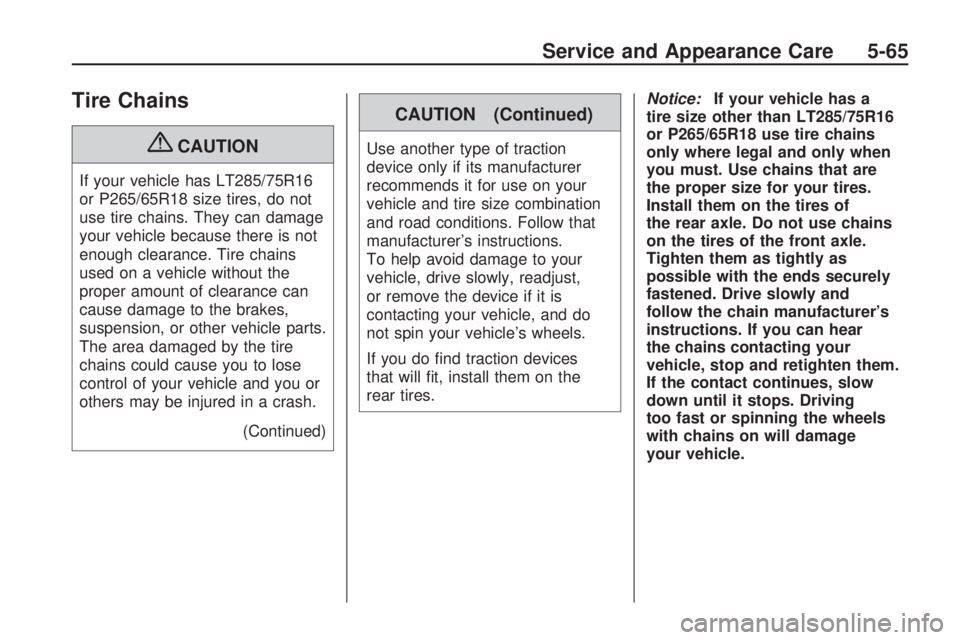
Tire Chains
{CAUTION
If your vehicle has LT285/75R16
or P265/65R18 size tires, do not
use tire chains. They can damage
your vehicle because there is not
enough clearance. Tire chains
used on a vehicle without the
proper amount of clearance can
cause damage to the brakes,
suspension, or other vehicle parts.
The area damaged by the tire
chains could cause you to lose
control of your vehicle and you or
others may be injured in a crash.
(Continued)
CAUTION (Continued)
Use another type of traction
device only if its manufacturer
recommends it for use on your
vehicle and tire size combination
and road conditions. Follow that
manufacturer’s instructions.
To help avoid damage to your
vehicle, drive slowly, readjust,
or remove the device if it is
contacting your vehicle, and do
not spin your vehicle’s wheels.
If you do �nd traction devices
that will �t, install them on the
rear tires.Notice:If your vehicle has a
tire size other than LT285/75R16
or P265/65R18 use tire chains
only where legal and only when
you must. Use chains that are
the proper size for your tires.
Install them on the tires of
the rear axle. Do not use chains
on the tires of the front axle.
Tighten them as tightly as
possible with the ends securely
fastened. Drive slowly and
follow the chain manufacturer’s
instructions. If you can hear
the chains contacting your
vehicle, stop and retighten them.
If the contact continues, slow
down until it stops. Driving
too fast or spinning the wheels
with chains on will damage
your vehicle.
Service and Appearance Care 5-65
Page 302 of 382
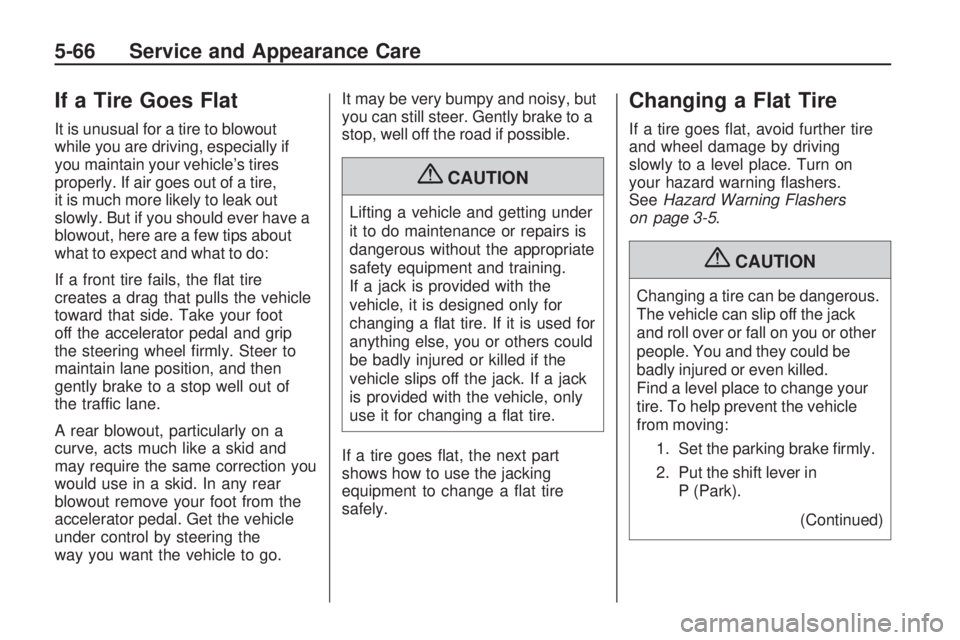
If a Tire Goes Flat
It is unusual for a tire to blowout
while you are driving, especially if
you maintain your vehicle’s tires
properly. If air goes out of a tire,
it is much more likely to leak out
slowly. But if you should ever have a
blowout, here are a few tips about
what to expect and what to do:
If a front tire fails, the �at tire
creates a drag that pulls the vehicle
toward that side. Take your foot
off the accelerator pedal and grip
the steering wheel �rmly. Steer to
maintain lane position, and then
gently brake to a stop well out of
the traffic lane.
A rear blowout, particularly on a
curve, acts much like a skid and
may require the same correction you
would use in a skid. In any rear
blowout remove your foot from the
accelerator pedal. Get the vehicle
under control by steering the
way you want the vehicle to go.It may be very bumpy and noisy, but
you can still steer. Gently brake to a
stop, well off the road if possible.
{CAUTION
Lifting a vehicle and getting under
it to do maintenance or repairs is
dangerous without the appropriate
safety equipment and training.
If a jack is provided with the
vehicle, it is designed only for
changing a �at tire. If it is used for
anything else, you or others could
be badly injured or killed if the
vehicle slips off the jack. If a jack
is provided with the vehicle, only
use it for changing a �at tire.
If a tire goes �at, the next part
shows how to use the jacking
equipment to change a �at tire
safely.
Changing a Flat Tire
If a tire goes �at, avoid further tire
and wheel damage by driving
slowly to a level place. Turn on
your hazard warning �ashers.
SeeHazard Warning Flashers
on page 3-5.
{CAUTION
Changing a tire can be dangerous.
The vehicle can slip off the jack
and roll over or fall on you or other
people. You and they could be
badly injured or even killed.
Find a level place to change your
tire. To help prevent the vehicle
from moving:
1. Set the parking brake �rmly.
2. Put the shift lever in
P (Park).
(Continued)
5-66 Service and Appearance Care
Page 303 of 382
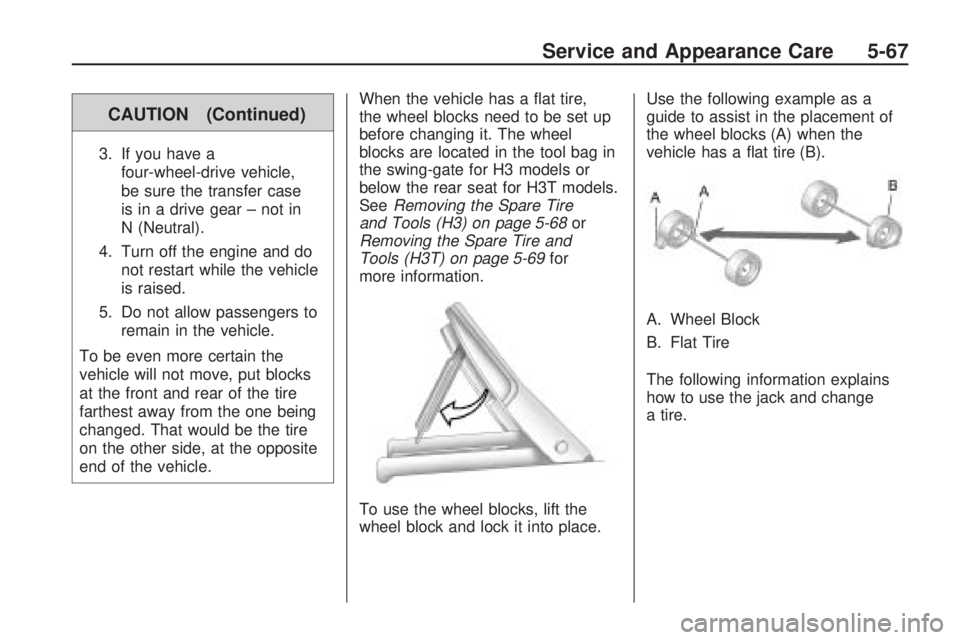
CAUTION (Continued)
3. If you have a
four-wheel-drive vehicle,
be sure the transfer case
is in a drive gear – not in
N (Neutral).
4. Turn off the engine and do
not restart while the vehicle
is raised.
5. Do not allow passengers to
remain in the vehicle.
To be even more certain the
vehicle will not move, put blocks
at the front and rear of the tire
farthest away from the one being
changed. That would be the tire
on the other side, at the opposite
end of the vehicle.When the vehicle has a �at tire,
the wheel blocks need to be set up
before changing it. The wheel
blocks are located in the tool bag in
the swing-gate for H3 models or
below the rear seat for H3T models.
SeeRemoving the Spare Tire
and Tools (H3) on page 5-68or
Removing the Spare Tire and
Tools (H3T) on page 5-69for
more information.
To use the wheel blocks, lift the
wheel block and lock it into place.Use the following example as a
guide to assist in the placement of
the wheel blocks (A) when the
vehicle has a �at tire (B).
A. Wheel Block
B. Flat Tire
The following information explains
how to use the jack and change
a tire.
Service and Appearance Care 5-67
Page 304 of 382
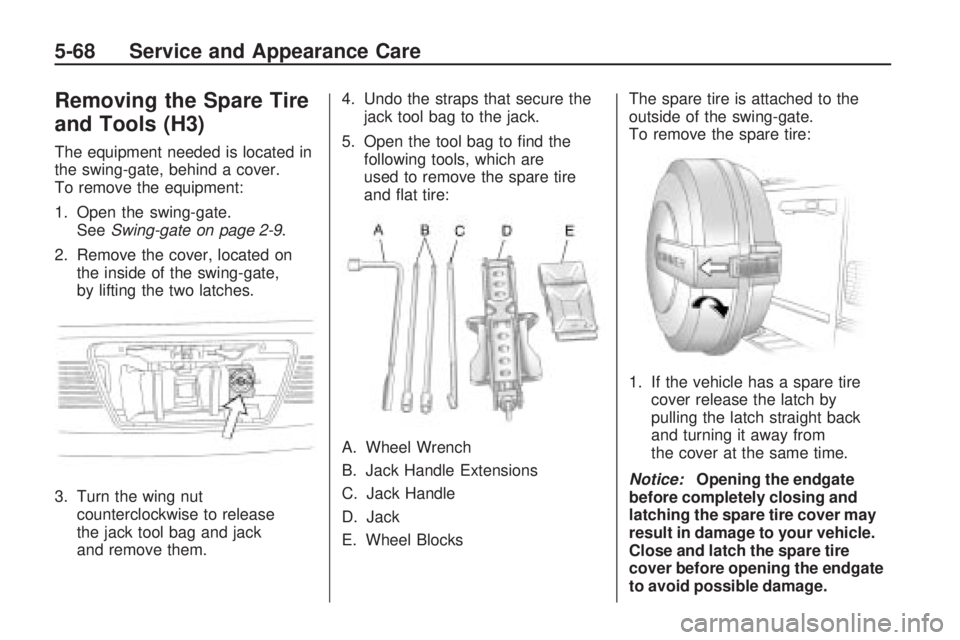
Removing the Spare Tire
and Tools (H3)
The equipment needed is located in
the swing-gate, behind a cover.
To remove the equipment:
1. Open the swing-gate.
SeeSwing-gate on page 2-9.
2. Remove the cover, located on
the inside of the swing-gate,
by lifting the two latches.
3. Turn the wing nut
counterclockwise to release
the jack tool bag and jack
and remove them.4. Undo the straps that secure the
jack tool bag to the jack.
5. Open the tool bag to �nd the
following tools, which are
used to remove the spare tire
and �at tire:
A. Wheel Wrench
B. Jack Handle Extensions
C. Jack Handle
D. Jack
E. Wheel BlocksThe spare tire is attached to the
outside of the swing-gate.
To remove the spare tire:
1. If the vehicle has a spare tire
cover release the latch by
pulling the latch straight back
and turning it away from
the cover at the same time.
Notice:Opening the endgate
before completely closing and
latching the spare tire cover may
result in damage to your vehicle.
Close and latch the spare tire
cover before opening the endgate
to avoid possible damage.
5-68 Service and Appearance Care
Page 305 of 382
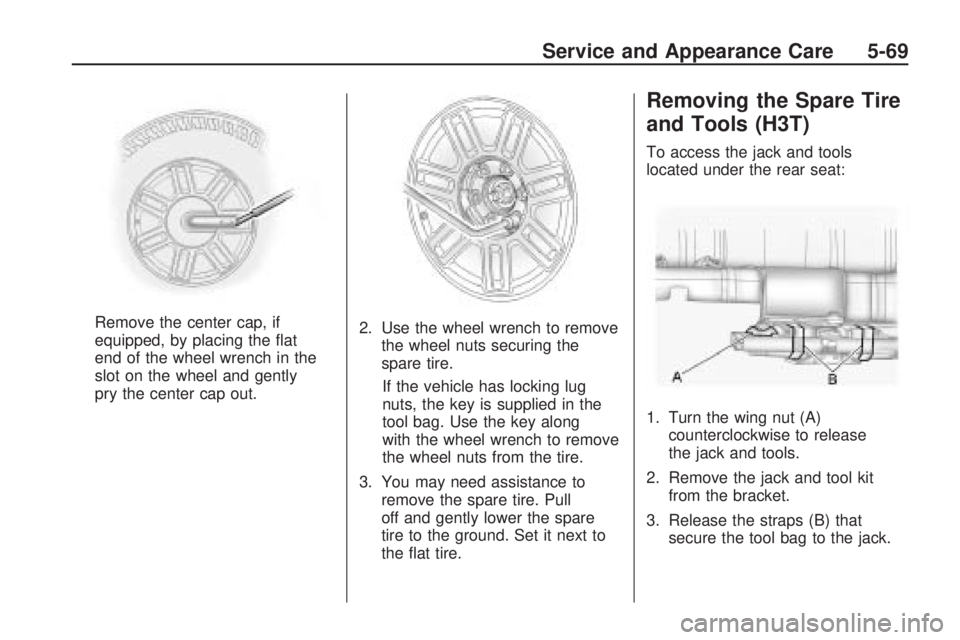
Remove the center cap, if
equipped, by placing the �at
end of the wheel wrench in the
slot on the wheel and gently
pry the center cap out.2. Use the wheel wrench to remove
the wheel nuts securing the
spare tire.
If the vehicle has locking lug
nuts, the key is supplied in the
tool bag. Use the key along
with the wheel wrench to remove
the wheel nuts from the tire.
3. You may need assistance to
remove the spare tire. Pull
off and gently lower the spare
tire to the ground. Set it next to
the �at tire.
Removing the Spare Tire
and Tools (H3T)
To access the jack and tools
located under the rear seat:
1. Turn the wing nut (A)
counterclockwise to release
the jack and tools.
2. Remove the jack and tool kit
from the bracket.
3. Release the straps (B) that
secure the tool bag to the jack.
Service and Appearance Care 5-69
Page 306 of 382
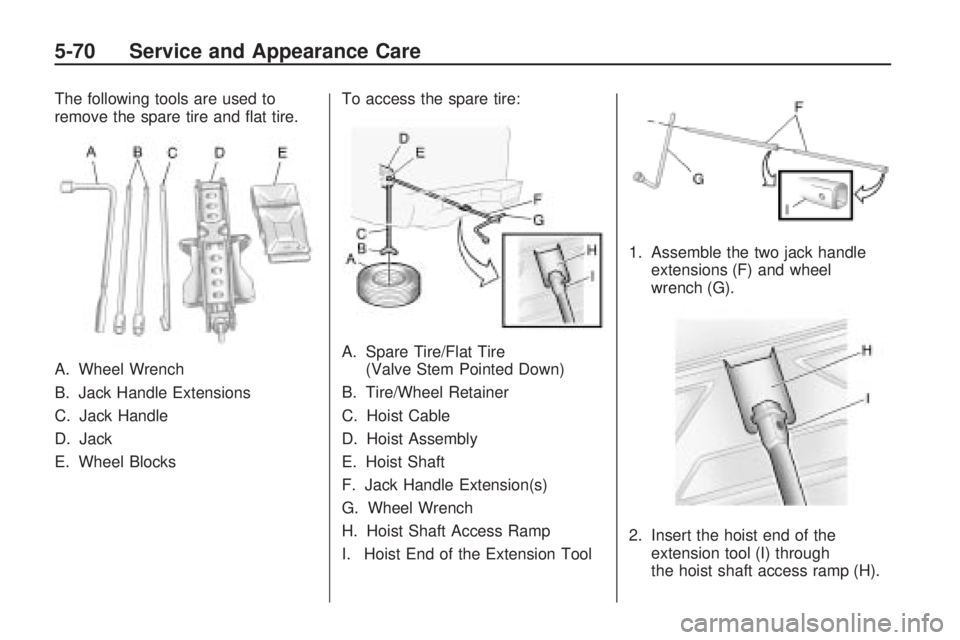
The following tools are used to
remove the spare tire and �at tire.
A. Wheel Wrench
B. Jack Handle Extensions
C. Jack Handle
D. Jack
E. Wheel BlocksTo access the spare tire:
A. Spare Tire/Flat Tire
(Valve Stem Pointed Down)
B. Tire/Wheel Retainer
C. Hoist Cable
D. Hoist Assembly
E. Hoist Shaft
F. Jack Handle Extension(s)
G. Wheel Wrench
H. Hoist Shaft Access Ramp
I. Hoist End of the Extension Tool1. Assemble the two jack handle
extensions (F) and wheel
wrench (G).
2. Insert the hoist end of the
extension tool (I) through
the hoist shaft access ramp (H).
5-70 Service and Appearance Care
Page 307 of 382
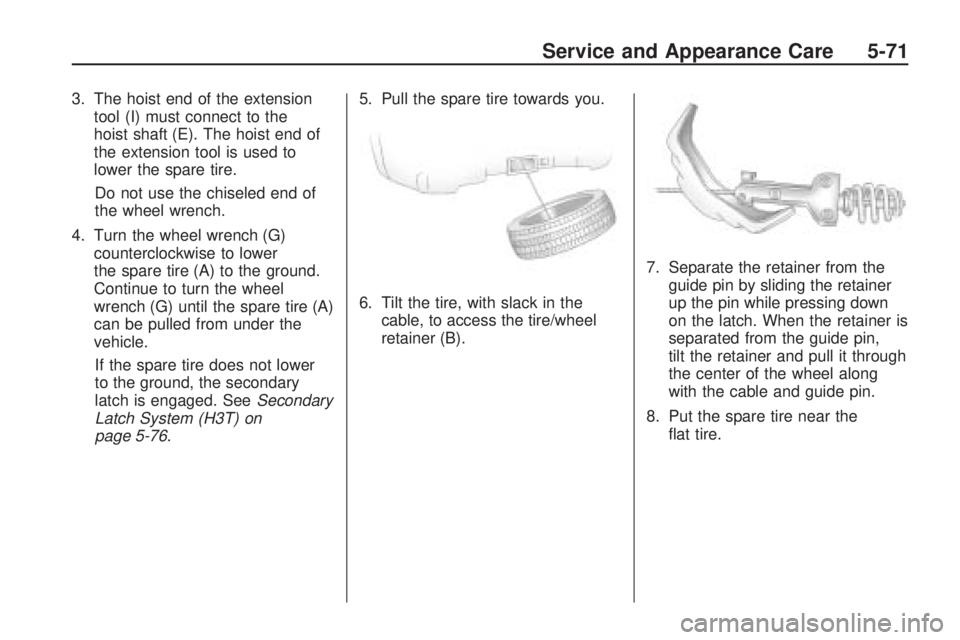
3. The hoist end of the extension
tool (I) must connect to the
hoist shaft (E). The hoist end of
the extension tool is used to
lower the spare tire.
Do not use the chiseled end of
the wheel wrench.
4. Turn the wheel wrench (G)
counterclockwise to lower
the spare tire (A) to the ground.
Continue to turn the wheel
wrench (G) until the spare tire (A)
can be pulled from under the
vehicle.
If the spare tire does not lower
to the ground, the secondary
latch is engaged. SeeSecondary
Latch System (H3T) on
page 5-76.5. Pull the spare tire towards you.
6. Tilt the tire, with slack in the
cable, to access the tire/wheel
retainer (B).7. Separate the retainer from the
guide pin by sliding the retainer
up the pin while pressing down
on the latch. When the retainer is
separated from the guide pin,
tilt the retainer and pull it through
the center of the wheel along
with the cable and guide pin.
8. Put the spare tire near the
�at tire.
Service and Appearance Care 5-71
Page 308 of 382
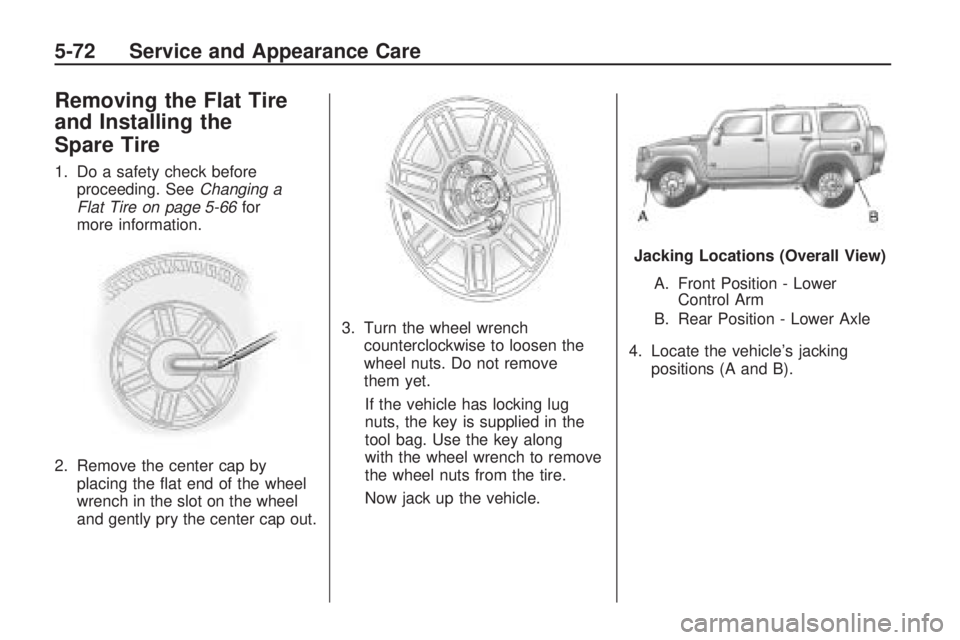
Removing the Flat Tire
and Installing the
Spare Tire
1. Do a safety check before
proceeding. SeeChanging a
Flat Tire on page 5-66for
more information.
2. Remove the center cap by
placing the �at end of the wheel
wrench in the slot on the wheel
and gently pry the center cap out.3. Turn the wheel wrench
counterclockwise to loosen the
wheel nuts. Do not remove
them yet.
If the vehicle has locking lug
nuts, the key is supplied in the
tool bag. Use the key along
with the wheel wrench to remove
the wheel nuts from the tire.
Now jack up the vehicle.A. Front Position - Lower
Control Arm
B. Rear Position - Lower Axle
4. Locate the vehicle’s jacking
positions (A and B).
Jacking Locations (Overall View)
5-72 Service and Appearance Care
Page 309 of 382
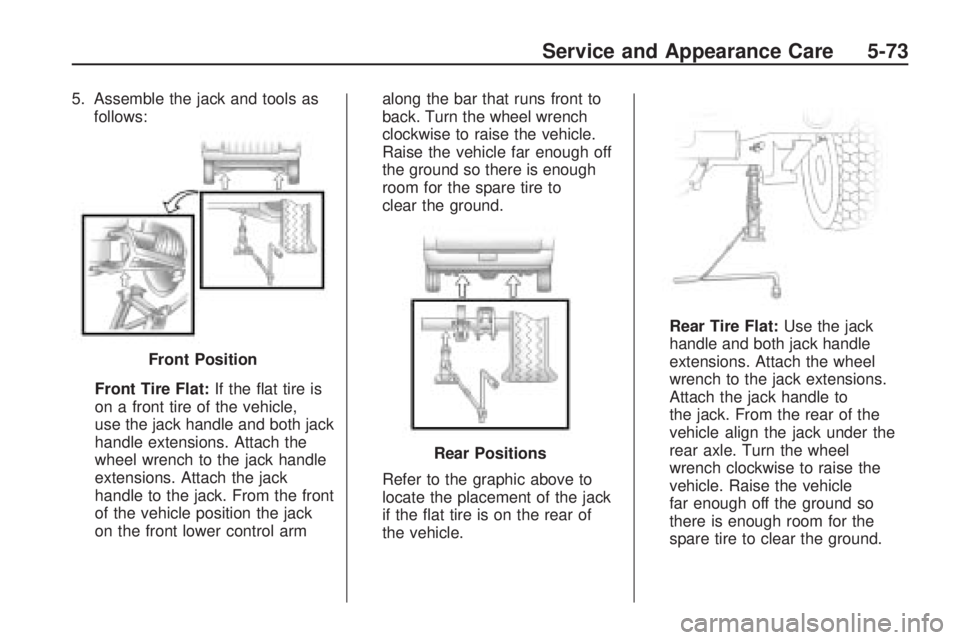
5. Assemble the jack and tools as
follows:
Front Tire Flat:If the �at tire is
on a front tire of the vehicle,
use the jack handle and both jack
handle extensions. Attach the
wheel wrench to the jack handle
extensions. Attach the jack
handle to the jack. From the front
of the vehicle position the jack
on the front lower control armalong the bar that runs front to
back. Turn the wheel wrench
clockwise to raise the vehicle.
Raise the vehicle far enough off
the ground so there is enough
room for the spare tire to
clear the ground.
Refer to the graphic above to
locate the placement of the jack
if the �at tire is on the rear of
the vehicle.Rear Tire Flat:Use the jack
handle and both jack handle
extensions. Attach the wheel
wrench to the jack extensions.
Attach the jack handle to
the jack. From the rear of the
vehicle align the jack under the
rear axle. Turn the wheel
wrench clockwise to raise the
vehicle. Raise the vehicle
far enough off the ground so
there is enough room for the
spare tire to clear the ground. Front Position
Rear Positions
Service and Appearance Care 5-73
Page 310 of 382
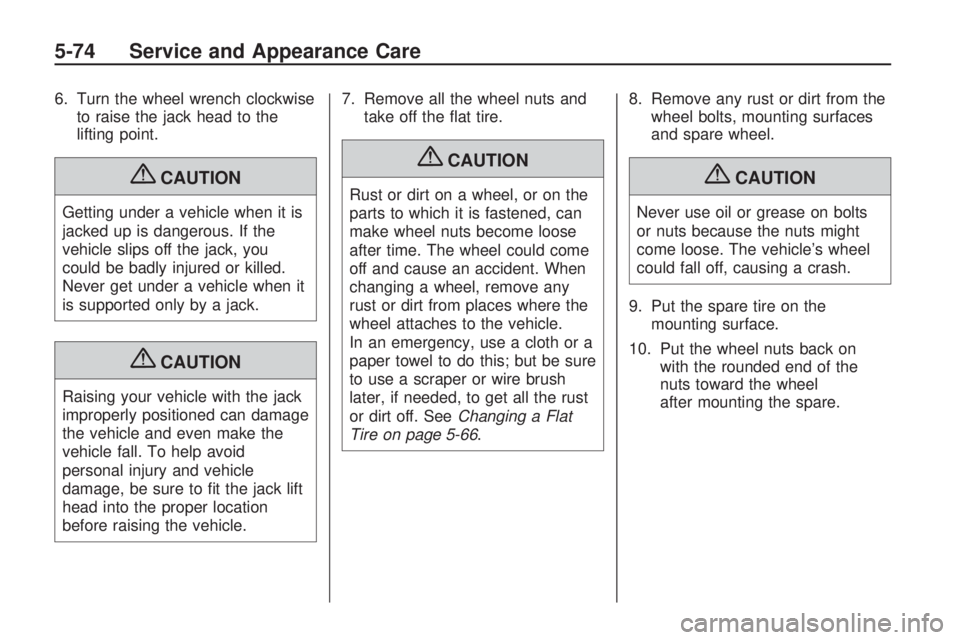
6. Turn the wheel wrench clockwise
to raise the jack head to the
lifting point.
{CAUTION
Getting under a vehicle when it is
jacked up is dangerous. If the
vehicle slips off the jack, you
could be badly injured or killed.
Never get under a vehicle when it
is supported only by a jack.
{CAUTION
Raising your vehicle with the jack
improperly positioned can damage
the vehicle and even make the
vehicle fall. To help avoid
personal injury and vehicle
damage, be sure to �t the jack lift
head into the proper location
before raising the vehicle.7. Remove all the wheel nuts and
take off the �at tire.
{CAUTION
Rust or dirt on a wheel, or on the
parts to which it is fastened, can
make wheel nuts become loose
after time. The wheel could come
off and cause an accident. When
changing a wheel, remove any
rust or dirt from places where the
wheel attaches to the vehicle.
In an emergency, use a cloth or a
paper towel to do this; but be sure
to use a scraper or wire brush
later, if needed, to get all the rust
or dirt off. SeeChanging a Flat
Tire on page 5-66.8. Remove any rust or dirt from the
wheel bolts, mounting surfaces
and spare wheel.{CAUTION
Never use oil or grease on bolts
or nuts because the nuts might
come loose. The vehicle’s wheel
could fall off, causing a crash.
9. Put the spare tire on the
mounting surface.
10. Put the wheel nuts back on
with the rounded end of the
nuts toward the wheel
after mounting the spare.
5-74 Service and Appearance Care